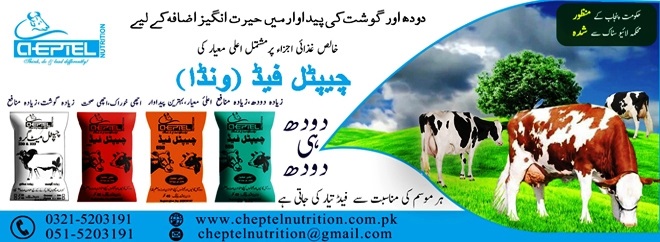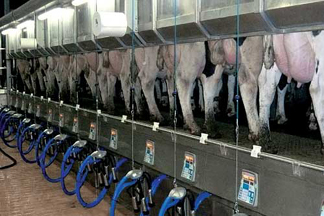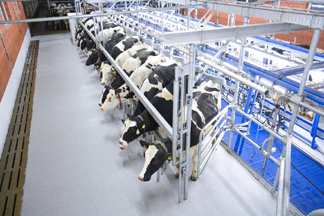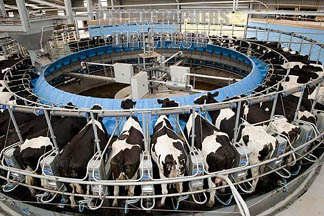|
Different types of milking parlours are given below:
Tandem Parlour:
The tandems parlour usually has two to six stalls at each side
of the pit. There are two types of tandem parlours, namely the
side-gate type and the walk-through type. The side-gate type has
entrance and exit gates on the one side of each milking stall, that
can be operated by hand or hydraulics. Tandem milking parlour is
especially suitable for smaller dairies (less than 100 cows) or for
stud farming.




Parallel Parlour:
In the parallel parlour, cows stand on an elevated platform at a
90-degree angle facing away from the operating area.
Access to the udder is between the rear
legs, which reduces visibility of the front quarters and can
make unit attachment and udder sanitation more difficult. A
partitioning door that swings when a cow enters the milking stall
opens the adjacent milking stall for the next cow. In most parlours,
the gates overlap, to prevent the cows from entering the milking
stall beforehand. As a cow enters the parlour, there is no milking
stall available to enter, except the last one in the line.

Herringbone (Fishbone) Parlour:
Cows
enter the fishbone parlour in groups and stand at an angle to the
milking pit, so that only the udder part of the cow is exposed to
the labourer. This layout reduces the distance between the udders
significantly and saves walking time for the labourers between
milking points. Many variations of the fishbone parlour, sometimes
called the 'para-bone', have been installed, which reduces the
distance between cows with 760 mm and 860 mm. Standard fish-bone parlours vary in size from 4 to 20 milking points at each side of
the pit. Fishbone parlours are suitable for dairies with 200 to 500
cows.

Rotating Parlour:
In the rotating parlour, cows are milked on a rotational, raised,
circle shaped platform. There are many variations of this type of
parlour, based on the way the cows stand on the platform. They can
stand in tandem, fishbone or parallel formation, with their heads
directed towards the inside or the outside of the platform. The most
logical choice is the parallel-type with the heads of the cows
directed inward, as this takes up the least space per cow. The
labourers remain in the same position on the outside of the
platform, while the cows move in rotation towards, them. The speed
of the platform can be controlled to give the labourers sufficient
time to prepare the cow and fit the claw piece.
The
advantage of the rotary parlor is that the cow movement functions
are largely automated, freeing the operators to tasks more directly
associated with milking. Rotary parlors typically
require three operators: one for unit
attachment, one to detach units and/or apply post milking
teat dip and one to tend to any problems occurring while cows are
traveling around. This
parlor type is not expandable and the capital cost is usually higher
per stall than for non-moving parlors. Because of these
characteristics, rotary parlors are best suited to larger herds
(>1000 cows).


|

![]()








